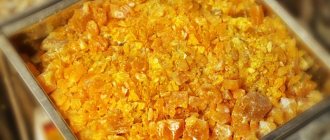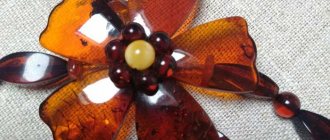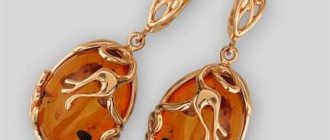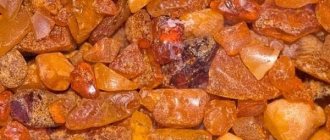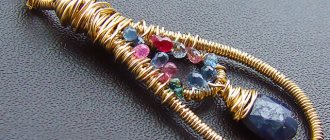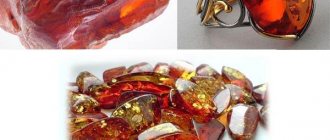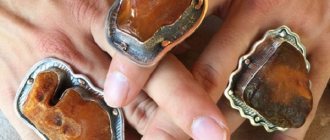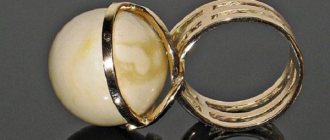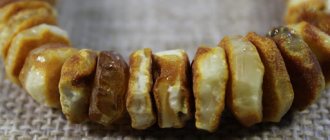Amber has long been used not only to create small jewelry; entire rooms are made from this stone. The stone contains many years of history of the planet, so amber is quite a valuable material. And many who want to have jewelry with such a stone are interested in whether it is possible to create artificial amber or purchase such a product somewhere. Of course, the procedure is labor-intensive, but the final cost is low and makes the stone affordable for most jewelry lovers.
Artificial amber
In nature, amber is formed from the resin or resin of coniferous trees. Scientists now argue that the type of tree is unimportant as stones made from leguminous plants have become common. Therefore, today amber is considered to be a material that is formed from resin or other tree sap and has also been in the ground for at least a million years.
Based on the varieties of amber, natural and climatic conditions are studied, as well as the flora and fauna of those times. Therefore, the stone is popular not only among jewelers, but also historians and geologists are interested in it. You can understand the state of the planet by inclusions, inclusions in the composition of the stone, which can be particles of plants, insects, and impurities from the soil.
Drilling amber
When assembling amber products together, sometimes you have to make holes in them; they can be through or of a certain depth. Drilling is carried out only with a hand drill or a slowly operating drill. The drill diameter is approximately 1 mm. It is replaced with a strong short iron wire with a sharp tip and a sewing needle without an eye. During the drilling process, a sharp tool is removed every 1 - 2 mm of the recess to clear it of dust. It is better to make holes before polishing the product. This will make it possible to hold the amber firmly in your hand and protect the product from scratches from the drill. To prevent small stones from cracking during drilling, it must sometimes be moistened with water or oil during operation. For a through hole, you must first drill one hole halfway through the stone, and then from the other side towards it. The technology will help avoid breaking and chipping when the drill comes out of the stone.
How to make amber?
You can make artificial amber with your own hands at home. In terms of time, this process will be much faster than it occurs in nature. To do this, you can use one of the following methods:
- Method one. Take turpentine resin, shellac and rosin in a 1:2:1 ratio. In a tin vessel, the walls of which must first be greased with oil, it is necessary to melt the turpentine. As the material melts, shellac is gradually added to it, the consistency of the mixture will become thick and take on a white tint. Continue heating the mixture until it becomes clear. After this happens, gradually pour in the pre-melted rosin. With gradual heating, the mass will become more and more transparent; the desired color will be obtained by choosing the appropriate shellac. The longer you heat this mixture, the darker it will be. And a stone created under such conditions will be quite hard. To soften its consistency a little, you should add a little more turpentine. The resulting imitation amber can be cast or shaped by pressing, after which the stone can be polished and ground. Remember that the composition is not sensitive to water, but is soluble in alcohol.
- The second method includes gelatin in the composition of artificial amber. But the version is more labor-intensive, since after pouring the gelatin into the bath, you will need to sprinkle it on top with crushed golden mica sparkles. After the mass has hardened, it is worth pouring a layer of gelatin again, covering it with glitter. The procedure must be carried out several times, and the top of the newly made stone must be coated with cherry varnish. By the way, this method is often used by restorers.
Since the mass is initially liquid, you can add some kind of leaf or insect to it for naturalness and thus imitate inclusions. And any jewelry is made from such amber, from beads to pendants. The cost of the techniques is much cheaper than natural stone. But you should not use it for industrial purposes, passing it off as amber, since the manufacture and sale of counterfeits is a criminal offense.
Artificial amber beads
Gluing a gem
Sometimes it is necessary to firmly connect the amber parts together. For gluing use:
- 50% aqueous solution of sodium or potassium, which is used to lubricate the surfaces of the parts, then heated to a certain temperature and pressed tightly together;
- amber varnish and sodium alcohol solution;
- celluloid solution;
- solution of solid copal in ether.
Varieties of amber imitations
There are several options for making amber:
- resins of other plants;
- Polyburn;
- ambroid;
- an artificially obtained alloy of polymer resins.
Group 1 includes:
- Copal is a hardened resin of legumes, for example, acacia, araucaria. Under pressure and temperature, a still fresh resin drop hardens, into which an insect is often slipped.
- The resin of the ancient kauri tree is released up to 0.5 tons in case of damage to the root of a large plant. Its chemical composition is not similar to amber; it is used for the production of varnishes, but after certain processing it hardens, resembling the original.
Polyburn is a stone created from amber crumbs and small pieces glued together - fragments of solar stone. It is given color and shine, but the components inside are clearly visible. The jewelry is cheaper than the original, production has practically stopped.
Ambroid is a heated and compressed crumb of amber. Opaque, composition identical to the original.
In the 2nd half of the 20th century, chemists synthesized substances used to imitate:
- Bakelite – 1st colored and tinted artificial plastic;
- faturan – bakelite modified in composition;
- celluloid - imitation was used to decorate the handles of cutlery;
- Galalite is a plastic made from casein;
- polyester – even premium products have been counterfeited.
View this post on Instagram
Post from Cat&Fox Jewelry Co. (@catfoxjewelry) Oct 16, 2015 at 2:15 PDT
Increased transparency
If amber stones are not as good as you would like, then they can be transformed. By removing air bubbles and liquids from the inside, the transparency of the stone will increase. To achieve such results, amber is boiled and calcined in rapeseed or linseed oil. During the boiling process, it is very important to monitor the temperature changes in the oil; cooling or heating should occur slowly.
Artificial amber products
By making molds or using objects around you that fit the molds, you can make beads, bracelets, pendants and other jewelry.
You can try to make a pendant with the inclusion of some vegetation (leaves, flower petals, etc.). Pendants with images of zodiac signs and names are very popular.
To make jewelry, you may additionally need to purchase chains for pendants, string for beads, and other materials. You can make a mosaic panel or a painting from artificial amber - these are more expensive things. Costs of producing artificial amber
- small, and your income will depend on the products that you can produce.
Amber staining
Cloudy amber is clarified using dry calcination. The gems are heated for a long time in sand heated above 100°. During cooling, micro voids “explode” inside the stones. Such processes lead to the formation of various sparkles - scales. The stone itself becomes a beautiful red-cherry color.
Various literary publications tell about several methods of coloring amber in various other colors. To obtain a different shade of the gem, it must be boiled in vegetable oil, in honey with the addition of dyes. However, recipes for such dyes are unknown.
How to polish amber?
If cleaning doesn't help restore the shine, polishing will probably do the trick. With its help, the surface is leveled, removing scratches, small chips and other defects. The light is evenly distributed over the entire coverage area, which contributes to its maximum reflection. But it should be borne in mind that sometimes amber is sold not in its pure form, but in colored form. The following colors may indicate that tinting has been carried out:
- red;
- bright orange;
- greenish;
- bluish;
- cognac
The listed tones for natural resin are unnatural. Tinted amber cannot be polished, it’s easy to see why. Only the top layer of the stone is painted; it will be partially removed during grinding. The end result is a spotty product that is not at all pleasing with its appearance.
Unpainted amber can and should be periodically “shake off the dust.” The best set for home polishing is considered to be a suede flap and paraffin.
Instead of suede, you can use wool, and instead of paraffin, soap. In all cases, polishing is dry, without water.
A slightly less gentle, but effective remedy is a sheet of coated paper. If the surface has become smooth, but the shine has not returned, then home repairs are unlikely to be possible. Some stones really need professional care.
Stone tumbling
Among the stone processing technologies, there is also a simpler, but relatively time-consuming process - “tumbling”. Small pieces of amber are rolled in a rotating drum, and abrasive powder is poured into them (sometimes it is replaced with fine grain). This mixture is moistened with water or an alcohol solution to improve the adhesion of the abrasive and amber surfaces. Next, amber pellets are obtained, which are excellent raw materials for amber jewelry.
After processing the mineral, pressed amber is obtained from its waste. Small pieces unsuitable for work are further crushed, then heated to 140° - 150° C in a vacuum hydraulic press. The resulting molten amber is pressed into large blocks or produced into rods by passing them through round holes of a certain diameter. The parts are sawn into small pieces, from which beautiful beads or other shapes for jewelry are later turned.
Checking the stone
Amber testing can also be done at home. For this, methods have been invented that will not harm the real stone:
- If you put the material in a glass of salt water, the fake will sink, but real amber will float on the surface.
- You can try dropping acetone or alcohol onto the stone. If it is not a natural material, it will leave marks in the form of discoloration or melting.
- Cheap options made from artificial resins are easily scratched, which cannot be said about natural amber. Although the material obtained from nature is quite fragile and crumbles easily.
- If you are not afraid of damaging the product, try bringing a heated metal tool to it. If this is a decoration, then carry out the procedure on the wrong side. A smell will come from the melting point: if it is coniferous and pleasant, then the stone is natural. And if the smell gives off chemicals or plastic, then you have a fake amber in your hands.
But insects will not give an exact answer about authenticity, since even with artificial production, adding inclusions to a stone is quite simple. True professionals, of course, can distinguish whether an insect was placed in amber in a living form, or whether dead material was added. But this cannot be done without a magnifying glass and prior knowledge.
Physical properties of amber
In terms of hardness and melting point, amber surpasses the best varieties of copal (hardened oleoresin of Quaternary age). Amber dissolves in organic and terpene hydrocarbons.
Amber in its natural occurrence occurs in the form of pieces of various sizes, often reminiscent in shape of the resin secretions of modern coniferous trees:
- surface (stem), resulting from the flow of resin through cracks and all kinds of external damage to the wood;
- intra-trunk, formed under the bark of trees, in cavities between annual rings, in resin hollows and all kinds of pockets and voids.
Among the surface discharges, the most common are drop-shaped deposits, sinter plates, drops, stalactites with distinct imprints of twigs, bark and various irregularities of a tree trunk or forest floor. The intra-stem amber secretions are represented by slightly concave plates, thinning towards the edges. There are also secondary forms of resin secretions, the formation of which is associated with the transportation of amber by sea and river waters, glacial, water-glacial, aeolian and other geological reasons, which contributed to mechanical processing and crushing of various pieces into smaller ones. This is the reason for the variety of amber fragments weighing from fractions of a gram to ten or more kilograms. It is believed that the largest amber in the world, called "Burmese Amber", has a mass of 15 kg 250 g, it is kept in the Natural History Museum in London.
The density of amber is 0.97-1.10, which approximately corresponds to the density of sea water. Consequently, amber floats in salt water, but sinks in fresh water. This explains the amazing stability and indestructibility of amber, which has experienced repeated washing and transfer, as well as repeated reburial over tens of millions of years.
Amber melts on a candle flame, and at a temperature of 250-300°C it begins to boil. When heated, it smolders and burns with a white, smoky flame, spreading a pleasant resinous smell (a wonderful distinguishing feature from fakes!). In the Middle Ages, amber was used for fragrant fumigation of rooms. As a result of distillation, dark red amber oil, crystalline succinic acid and succinic rosin are obtained from it.
It is well known that when rubbed, amber becomes electrified and charged with statistical electricity, attracting small objects. This remarkable property of amber was probably first discovered by the ancient Greek philosopher Thales of Miletus (624-547 BC). Subsequently, scientists, seeing bluish sparks when rubbing amber with wool (these micro-discharges of lightning), called them electrons after the Greek name for amber. Amber is a good electrical insulator, its dielectric constant is 2.863. The hardness of amber on the Mohs scale is 2.0-3.0. The absolute hardness of succinite amber, due to the heterogeneity of its structure, varies widely - from 17.66 to 38.40 kg/mm2. It has been established that the hardness of pressed and natural amber is identical.
Amber colors
In general, amber is yellow in color. However, experts distinguish more than 200 color shades, which vary over a very wide range - from almost colorless to yellow, red, brown, white and even black. Opaque varieties are yellow, milky white (bone), pale yellow (ivory), lemon yellow, red-brown, smoky, brown and less commonly black in various shades. Most of the listed varieties can be observed in one piece of amber in the form of a strictly individual, unique color image.
The degree of transparency of amber also varies over a very wide range - from perfectly transparent varieties to opaque black ones. Opaque amber is also called bastard amber. When heated, opaque amber acquires a light golden color. Transparent varieties of amber are pale yellow, greenish, bright red and pale scarlet. Amber is valued not so much for the amazing richness of its sunny-golden color, but for the harmony of purity and transparency.
When exposed to ultraviolet rays, amber glows in different colors. The luster is glassy, resinous, less often waxy, and in bone it is matte. The burrow is uneven, conchoidal and semi-conchoidal, sometimes shell-like; for bone - flat, even.
Fashionable color, sweet taste and craquelure: cook amber in honey
Jewelers colored amber with sea purple, indigo and other natural dyes. The main condition was the ability of the latter to dissolve in fats, because gems were still boiled in goat fat or oil.
The most “delicious” coloring was honey - it gave the stones a reddish tint. But the craftsmen rarely used this recipe - the cracks spreading across the surface of the gems did not really suit them.
How amber is colored now
Let’s say for ourselves that under the “Amber Shop” brand you will not find a single painted gem. Black, green, cognac, cherry and other shades are created by nature itself.
Earrings with cherry-colored amber
However, there are few equally honest manufacturers of jewelry, paintings and souvenirs made of amber: some “cheat” by pressing and molding. The pebbles are cleaned, then ground into flour, dye is added, poured into molds, melted and cooled. That's the whole secret.
It is not difficult to distinguish a pressed craft from a natural mineral: clumps of color will be visible in it. A structure lacking uniformity will resemble a “patchwork quilt.” And, yes: fake amber will not pass the ultraviolet test - it will not be able to glow blue or green.
Related articles on the topic:
- Why does amber need car enamel? What about “Fairy”, the Soviet BF glue?
- What will water infused with amber be like and what to do with it?
- “Amber ages and becomes decrepit” – a myth or truth?
We always have promotions , many discounts up to 50%!!! We are waiting for you at: contacts…….. “Amber Shop”
In order not to miss announcements of interesting articles on and learn about news faster, subscribe to our
Yandex Zen and our groups on social networks:
Polishing stone at home
Whatever cleaning method you choose, polishing will make your stone shine with renewed vigor. For high-quality polishing, we recommend choosing a soft cloth, such as velvet or flannel. Polish the stone using gentle, circular motions. If these are beads, you need to polish each stone in turn.
Once polishing is complete, apply a few drops of olive oil to the material and rub the item well. As a result, your stone will gain a luxurious, glossy shine.
Clean and polish your jewelry regularly, and it will last you a long time, delighting you with its shine and beauty.
As you can see, there is nothing complicated in caring for amber. We hope that our advice will help you learn how to properly care for such products, and the sunstone will become your faithful companion. Wear amber jewelry with pleasure and make yourself happy.
Is the processed one more expensive? Heat it up and enlighten it!
Several centuries ago, fashionistas and fashionistas preferred... a surrogate to natural amber. This is what happened after long and sophisticated abuse of the pebble, so that it became absolutely transparent and acquired an unnaturally bright shade.
Cherry amber beads
Amber was “clarified” by boiling it in the lard of young pigs, which was later replaced with linseed and rapeseed oil. Only a small part of the gems processed in this way were inserted into jewelry. They were mainly used to create glasses and magnifying glasses - burning glasses, from which gunpowder flared up instantly.
Later, amber began to be “calcined” with sand heated to 150 degrees: this way it was not only “clarified”, but also filled with “fish scales” - a unique pattern of small, chaotic (like in a broken kaleidoscope) cracks appeared inside each mineral.
Some features of use
The unique properties of ambroid are in demand not only in the jewelry industry. It is actively used to create various insulating materials in instrument making and electrical engineering. It is used to make devices, utensils, and instruments for medical needs.
Amber is in particular demand for the production of equipment that accompanies the process of blood transfusion and storage. It has ultra-low wettability, inhibits the process of breakdown of red blood cells, hemolysis, being, as it were, a natural preservative.
Chemical composition of amber
It is dominated by succinoresen C22H36O2 (65%) and succinoabietic acid C25H40O4 (17%). Unlike the resin of modern pine trees, amber is almost completely free of abietic acid, which during the fossilization process was transformed into succinoresen, bornyl alcohol and polyesters of succinic acid (up to 70%). However, succinic acid (C4H604) is one of the most important diagnostic characteristics of amber. It is present in the products of its dry distillation in an amount of 3-8%.
